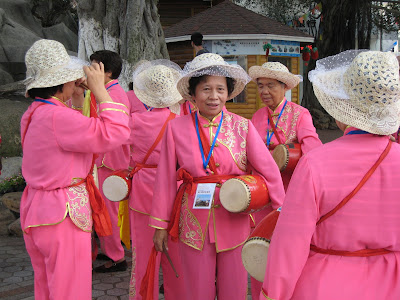It was a hot and non-blustery day. The humidity was sky-high and the crowds were fierce. After packing us all into a waiting area, they packed us on to the ferry for a ten minute ride. The constant haze that blurs the view of the sea was in full force as we approached the island of Gulang Yu. So as we got closer, we could actually see houses, parks, roads, and statues. Here is an imposing one; although, I didn't catch his name.

Calliope found a moment of tranquility beside a banyan tree whose roots were flooding down a rock face.

Down one of the many quaint side streets we came to another statue, but more fun was the graffiti, written in Chinese characters, of course. You can probably guess what it says.

So-and-so loves so-and-so.
Speaking of love, a famous doctor was born on Gulang Yu. She chose to stay to care for the sick and needy, even during China's terrible tragedies. She is honored with a monument consisting of a set of polished stones carved as if they are pages from a book of her famous quotes.

|

|
There are quite a few old European-style houses, in various states of disrepair. The island is famous for this part of its history, but admittedly, between the heat and the traveling gangs of Chinese tourists, it did not capture my imagination as I thought it would. Consider this an obligatory picture.

There were two bright spots at Shuzhuang Garden - the piano museum and the bonsai plants. The piano museum housed an impressive collection of pianos from the last two centuries. Many of them had these cool lamps built into the piano. Before electricity, this must have been a nice touch. Additionally, and given the circumstances in which we found ourselves, the museum was air conditioned! No photography was allowed in the museum, so I stole this shot from the AmoyMagic website.
 Near the exit from the piano museum was a lovely hill of bonsai ficus plants.
Near the exit from the piano museum was a lovely hill of bonsai ficus plants.

As we made our way around the island and back to the ferry dock, we walked through two tunnels. Talk about earth cooling! It felt exactly like air conditioning blowing out the tunnel entrances. Speaking of walking, I should mention that no cars or bicycles are allowed on the island. So, the primary mode of transportation is walking. We walked over to buy our return tickets, only to be drawn off-course by women in bright-colored costumes, drums, and fans. And they were about to perform! They loved having their pictures taken as they waited for their turn in the limelight.



Women, as well as a few men, wear the most outlandish English phrases on their shirts. They are generally grammatically incorrect. Some offer misspellings. And, for the most part, they are all humorous, or at least they make you think, until you break out laughing, because you have no idea what it all means. I don't believe I've seen a single shirt with Chinese characters, so I don't think this has some historical significance. One young man had the phrase "Girl sex" written all over his shirt. He did not seem to have a clue what it meant. One of the dancers carried her bag promoting a concert tour by The Minutemen, The Meat Puppets, The Descendents, and Angst. I thought this was just another odd set of English words, until Tom told me that they are all really well known thrash rock groups. It seems I, too, have no idea what the writing on some of these shirts means.






Very nice write-up about Gulang Yu. The first picture -- the man on the rock -- is Koxinga, the local dialect (minnan)for Zheng Chenggong. He is a national hero for liberating Taiwan in 1661 from the Dutch colonists in the early days of the Qing Dynasty and returning it to China. You can read details about him at http://en.wikipedia.org/wiki/Koxinga. I have a very interesting 2000movie SINO-DUTCH WAR 1661, which I'd be happy to loan you when you get back to Sarasota.
ReplyDeleteThe third picture (grafitti on bamboo) actually says Li3 loves Li4 -- a perfect example of where the same syllables pronounced with different tones become altogether different names.